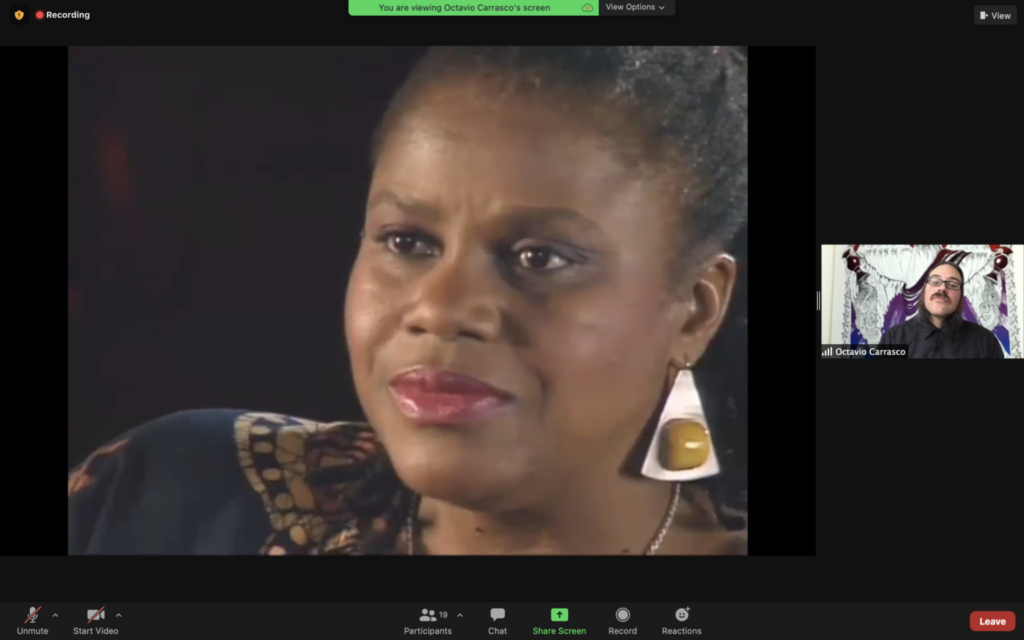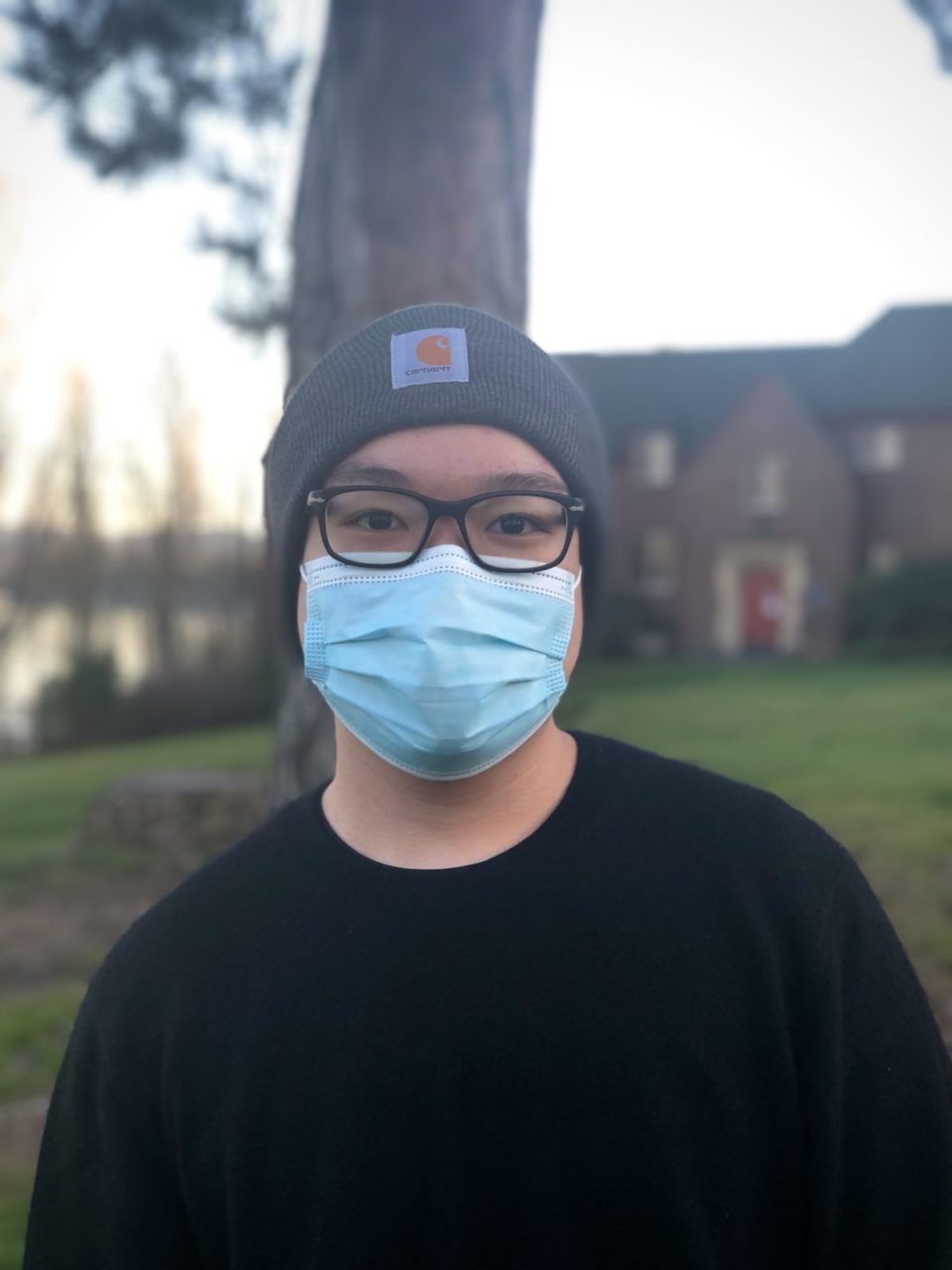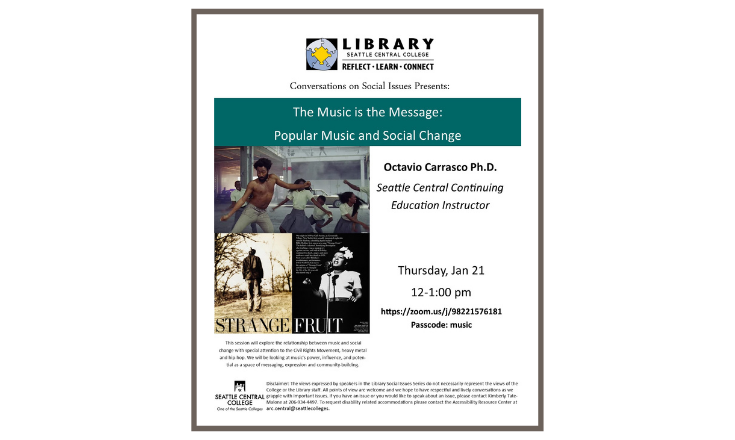On the early afternoon of Jan. 24, the very first COSI (Conversations on Social Issues) of the year, “Music is the Message”, sparked conversation about music and social change. Kimberly Tate-Malone, a librarian at Seattle Central College and the coordinator of this meeting, started off the event by paying tribute to the indigenous people of the Puget Sound Area with a land acknowledgement. After giving a brief introduction to the event, she passed the spotlight to Dr. Octavio Carrasco, a Doctor of Philosophy in Modern Religious History.
Dr. Carrasco began by asking the audience to introduce themselves with their names, their mother’s mother’s name and their language. He later explained that this activity helps him get to know the participants better and connect them as one.
To set the tone for the event’s topic, Dr. Carrasco asked the participants an open question: “Is the message music?”
He emphasizes his interest in the role of music during the construction of one’s identity, as it is space for both resistance and affirmation. Through this, he hopes to find out what people share in common through music.
He then continued the discussion by explaining his theory of music where harmonies and melodies exist in everyone’s mind. Dr. Carrasco also spoke on how music can invite people to feel a certain way and convey messages as “vehicles” through sound and vibration. Most importantly, he believes that music has a strong relationship to social change, where it acts as a space of potential.
During the Civil Rights Movement, music served as a form of communication, where it encouraged a change in attitude and the willingness to take action against Jim Crow laws, segregation, and the political structure at the time. Through this example, Dr. Carrasco emphasizes the significance of music in history.
To define popular music, Dr Carrasco set the framework up by posing questions to the audience about whether it is mass produced, aimed to please everyone, or shallow. As everyone has a different way to identify and interpret popular music, he believes that there is no way it can be coined by one single definition.
Responding to the debate about whether popular music belongs to the high culture or low culture, Dr. Carrasco says “everyone is capable of music, arts and creating”.
Participants were then asked to define “social change”. Many responses included a shift in shared perspective, transformation in society, or to improve social conditions. Dr. Carrasco then shared his own definition of it as “how people change the way they present themselves and their self-awareness in society”. To provide a better context, he referred to the 60’s when a lot of people had long hair, earrings, tattoos or dyed hair, which all empower one’s personality and characteristics.
As the Civil Rights Movement progressed during the 1950’s to the end of the 1960’s, Dr. Carrasco said the movement was the result of hundreds of years of thought, practice, and activities, and its impact on society can still be seen clearly today. By analyzing the music of the Civil Rights Movement, he showed the audience what it did to the people, how it affected them and gave them strength.
An example that was given to the audience is an interview titled “The Songs are Free” with Bernice Johnson Reagon, who was a student activist during the Civil Rights Movement in Albany, Georgia.

Through parts of the interview, Dr. Carrasco emphasized how music can be a powerful component of transformation which in this example is the transformation of society after the movement. Agreeing with him, the audience believed that the songs gave them self-confidence, lifted their spirits, and encouraged them to reach out to the community- connecting each other as one like Dr. Carrasco alluded to earlier in the event.
As the event neared an end, participants were split into breakout rooms to share their personal experiences with music and how it made them feel. One participant expressed their disappointment with how modern artists covered songs without any feelings or soul, and it made what used to be so good seem like a bland and hasty product. Dr. Carrasco pointed out how this is an example of the downside of popular music.
Regardless of any good or bad memories that anyone has about music from the past, its impact can be rekindled in seconds, something that today’s popular music is not able to do.
To wrap up the first COSI event of 2021, Dr. Carrasco provided a summary of his presentation- Music can function in many different ways, and through the Civil Rights Movement, it has proven its role as a “vehicle” of empowerment, a form of communication, and a tool for organizing. Through its legacy from the 1960’s onward, we should consider the impact of music on society.
Before ending, Dr. Carrasco gave everyone a last question: In today’s society, what is the relationship between music and social movements?
Author

Thang is a young student who is working towards an A.B at Seattle Central College while enjoying his hobby of being a staff writer at the Collegian. He's interested in cuisines around the world, listening to R&B music, sharing his perspectives of the world through writing and he is an avid car enthusiast. His dream is to greet the world with warm hugs and having a good time with everyone.







Be First to Comment